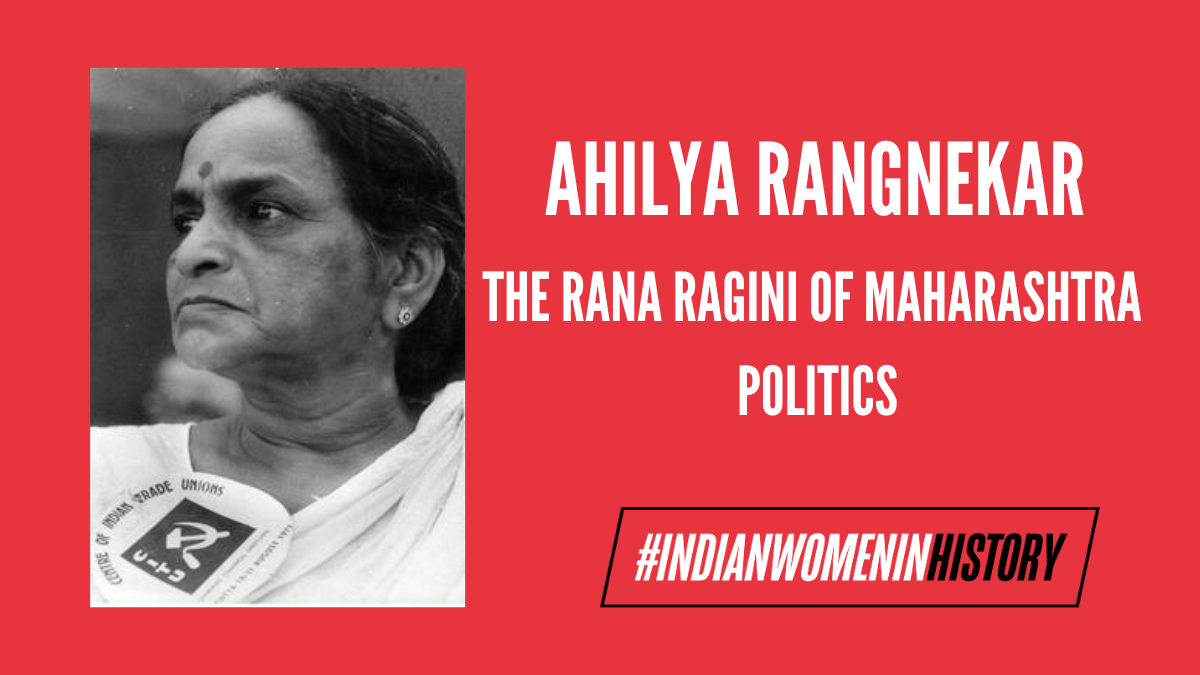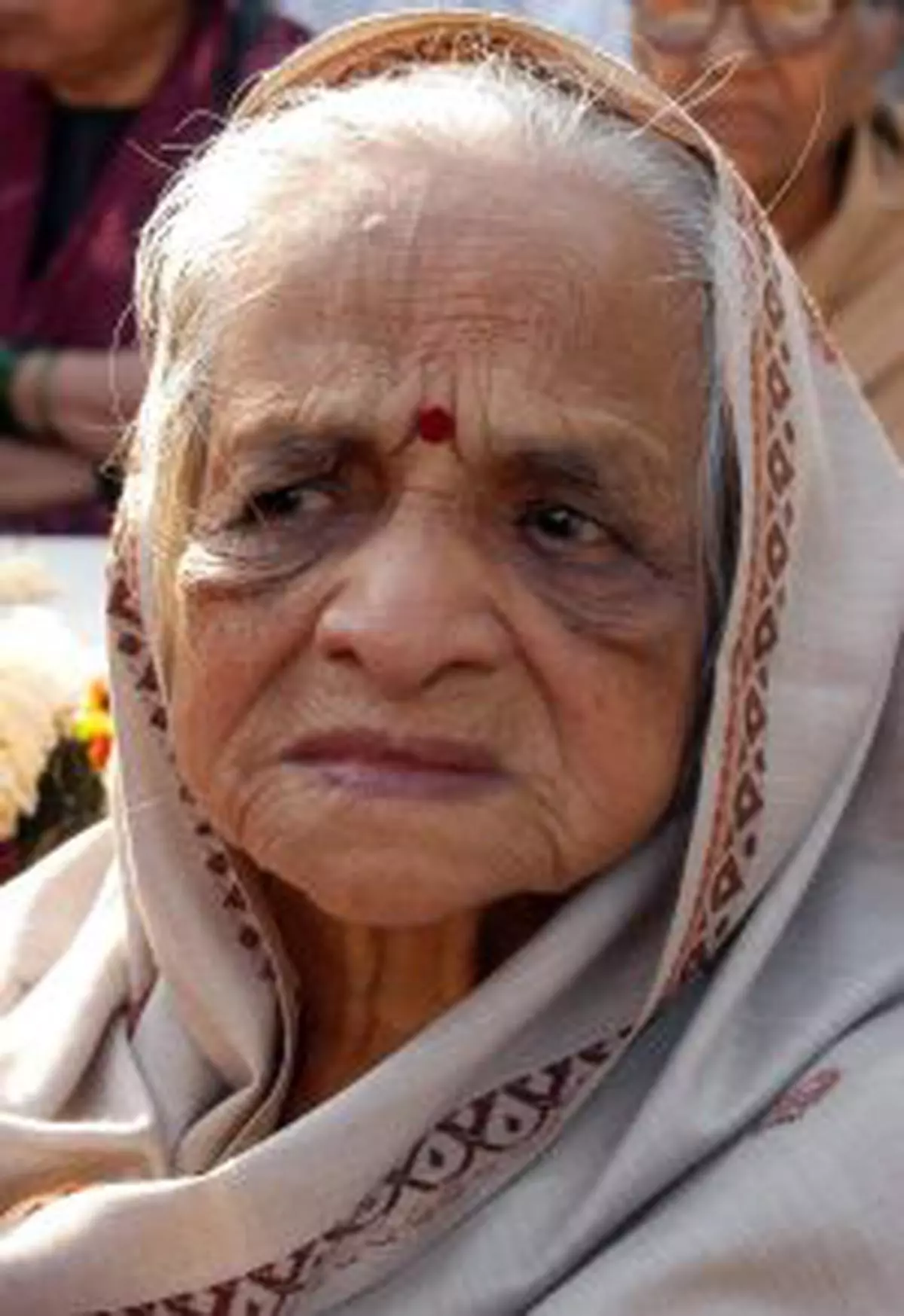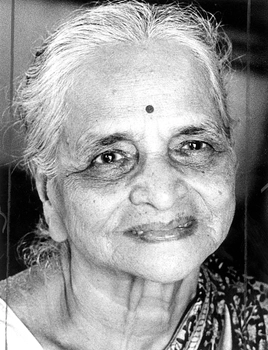Ahilya Rangnekar, the dauntless revolutionary of the 1940s who relentlessly worked for the upliftment and elevation of the oppressed communities and led the foundation for the progressive women’s movement in Maharashtra, was one of the country’s first women politicians. She is remembered for her selfless commitment to the freedom struggle, and the mobilisation of women, especially working-class women, to fight for their rights and socio-economic causes.
She is remembered for her selfless commitment to the freedom struggle, and the mobilisation of women, especially working-class women, to fight for their rights and socio-economic causes.
Rangnekar was born in Pune into a progressive reformist family on July 8, 1922. The youngest daughter to Trimbak Ranadive who himself strongly opposed any kind of discrimination based on caste, religion, or gender. He also supported the Social Reform movement led by Mahatma Jyotirao Phule. Ahilya, along with her sisters, and her sister-in-law had accomplished their graduation. Her elder brother BT Ranadhive, a Communist leader, who was at the forefront of the communist movement had an impeccable influence on her.
An emerging woman leader
In 1942 at the age of 20, she started pursuing a BSc. at Fergusson College, where began her activism with the declaration of the Quit India movement. She along with several female students led a protest rally at Pune in opposition to the incarceration of congress leaders and the death of Mahatma Gandhi’s secretary Mahadevbhai Desai in jail. This incident was followed by the arrest of the protestors including Ahilya
Even the imprisonment did not deter her from fighting injustice. As a Class B prisoner in the Yeravda jail, she along with other inmates and Indutai Kerkar mobilised women inmates from Class C prison, collected saris from them, and hoisted a tricolour National flag stitched from the saris, forming a human pyramid on the prison wall. This led to an extension in her prison term which was a three-month term before. This also resulted in her rustication from her college and her arrival in Ruia College, Mumbai for completion of graduation.
Bombay, known for its prominence in trade, necessitated the establishment of a trade union. Drawn by the hardships of the mill workers, Rangnekar joined the trade union, Girni Kamgar Union which had a strong base among the mill workers and their family members.
Given the values she has received from her family and having been inspired by her brother, it was not astonishing to note that she had joined the Communist Party in the year 1943. She and other female freedom fighters founded the Parel Mahila Sangh to mobilise the women in the Lal Bagh Parel area and work for their rights. The Mahila Sangh transformed into a true feminist organisation that championed better working conditions and the rights of working-class women. Among their demands, the implementation of better wages for women and mandatory maternity benefits were two of the significant achievements of the Mahila Sangh. The organisation also actively mobilised women to protest against the escalating prices of essential consumer commodities. The Mahila Sangh’s efforts were instrumental in bringing attention to the issues related to the economic empowerment of women and gender equality.
The Mahila Sangh later transformed into the Shramik Mahila Sangh, which subsequently merged with the Akhil Bharatiya Janwadi Mahila Samiti or the All India Democratic Women’s Association (AIDWA founded in 1981. Rangnekar continued to actively participate in every event organised by the association until her health declined. Her unwavering dedication and involvement in the association’s activities are a testament to her commitment to the upliftment of women and the progress of the feminist organisation in India.
Gail Omvedt quotes Ahilya Rangnekar, in Rural Origins of Women’s Liberation in India, ‘When women take part in the movement, its quality is different. Women are more militant, more lasting, and have a tenacity to fight…’
Rangnekar has time and again proven herself to be a true feminist leader. Gail Omvedt quotes Ahilya Rangnekar, in Rural Origins of Women’s Liberation in India, ‘When women take part in the movement, its quality is different. Women are more militant, more lasting, and have a tenacity to fight…’
One of her most dynamic contributions can be traced to the historic Royal Indian Navy revolt of 1946 in Mumbai. While the Muslim League and the Indian National Congress opposed the revolt and asked the Indian sailors to surrender to the British, the Communist Party of India offered support to the rebellion. It became the nationwide party to do so. She had been along with the women’s organisation at the forefront to support and supply food to the naval ratings. On 22 February 1946, when police opened fire on unarmed textile workers, Rangnekar’s sister Kusum Ranadive was shot in the leg by the British bullets, Rangnekar managed to escape the firing but her friend Kamal Donde was martyred.
India’s independence did not halt the functioning of the Mahila Sabha now the Maharashtra state unit of AIDWA. They continued to function for the rights of all sections of the oppressed including women and Dalits.
In the 1950s, yet again Rangnekar mobilised support from the organisation in favour of The Hindu Code Bill of 1950 that forbade bigamy, which was spearheaded by none other than Babasaheb Ambedkar. The Bill was opposed by MS Golvalkar, the Rashtriya Swayamsevak Sangh (RSS), and the Hindu conservatives, predominantly the upper caste Hindus. Even though they were affirmed to be against religion, they continued to seek support from chawl to chawl in erstwhile Bombay.
The Rana Ragini Ahilya
Prahlad Keshav Atre, a Marathi journalist, poet, and a prominent leftist activist of the iconic Maharashtra Samyukta Samiti had described her as the Rana Ragini Ahilya (Queen of the battlefield) in a poem he dedicated to her due to her fearless participation in the Samyukta Maharashtra Movement. Prahlad Keshav Atre was also part of this movement, which was one of the mass struggles Ahilya was a part of along with the Communist party, the Praja Samajwadi party, and several peasants and workers. This was a movement for a separate state of Maharashtra on a linguistic basis with Bombay as its capital. She had mobilised a large number of women for the same which landed her in jail and was subjected to lathi.
In the 1950s, yet again Rangnekar mobilised support from the organisation in favour of The Hindu Code Bill of 1950 that forbade bigamy, which was spearheaded by none other than Babasaheb Ambedkar.
Around the 60s she devoted her life to working for the people living in the slums and later in 1961 she was elected as the municipal corporator of Bombay Municipal Corporation and was continuously re-elected to the post for the next 19 years till 1977 when she was elected to the Parliament. In the Corporation, she had raised various issues of the slum occupants gaining her popularity amongst the community, even addressing their rallies.
Along with the other communist leader Rangnekar was incarcerated for three and a half years during the Indo-China conflict from 1962-1966 for suggesting a solution through negotiation for the dispute.
When the Centre of Indian Trade Union (CITU) was founded in 1970 in Kolkata, she made efforts to build a Maharashtra state unit of the same and was elected as the vice-president of the state unit of CITU. She was elected to the General Council in 1975 and was elected as the national vice-president in 1979. She played a prominent role in conducting the first convention of working women in Madras in the same year along with Vimal Ranadive and Sushila Gopalan.
She was once again detained for 19 months till 1977, when she opposed the dictatorial proclamation of Emergency 1975 by the Indira Gandhi government suppressing the democratic rights of the press and the citizens of the country.
She served as the Maharashtra state secretary of Communist Party of India(Marxist) (CPI(M)) from 1983 until she had to step down in 1986 owing to the deterioration in her eyesight. In an article published in People’s Democracy and Loklahar by Dr. Ashok Dhawale, a Polit Bureau Member of the CPI(M) and a close associate of Rangnekar mentions how she would be in touch with him, who was now the state secretary of the party, to understand the happenings of the party as she was unable to read the party papers due her failing vision. For Dhawale, Rangnekar whom he fondly called Ahilyatai was an inspiration since his time in college, when he was a member of the Student Federation of India (SFI), the student wing of the CPI(M).
The veteran died in 2009 at her residence in Mumbai at the age of 87. Since she was 20 years old, she had devoted her life to the public interest, the upliftment of progressive women’s organisation, and fighting against injustice, vehemently opposing any undemocratic practice or oppression of individuals.
Githa Hariharan in her A Woman of Substance-Remembering Ahilya Rangnekar recalls the first time she had seen Rangnekar in a protest against a policeman for committing rape of a girl.
Githa Hariharan in her A Woman of Substance-Remembering Ahilya Rangnekar recalls the first time she had seen Rangnekar in a protest against a policeman for committing rape of a girl. She saw a middle-aged Rangnekar climb over onto a lorry leading the rally. She explains how that event politicised her by the image of a ‘strong little woman’, defining her as a ‘woman of substance’. It is a necessity in contemporary India, to keep the works and contributions of idealistic women leaders such as Ahilya Rangnekar alive at a time when democracy itself is in question.
About the author(s)
Hrithika Haridas (she/her) is a final year MA Communication (Media Practice) student at the University of Hyderabad. She tries to look at things through the political, gender, class, and caste lens unlearning and relearning conventional normatives pushed on to us. She wants to be an inclusive content creator, inclusive of caste, class and gender minorities.









